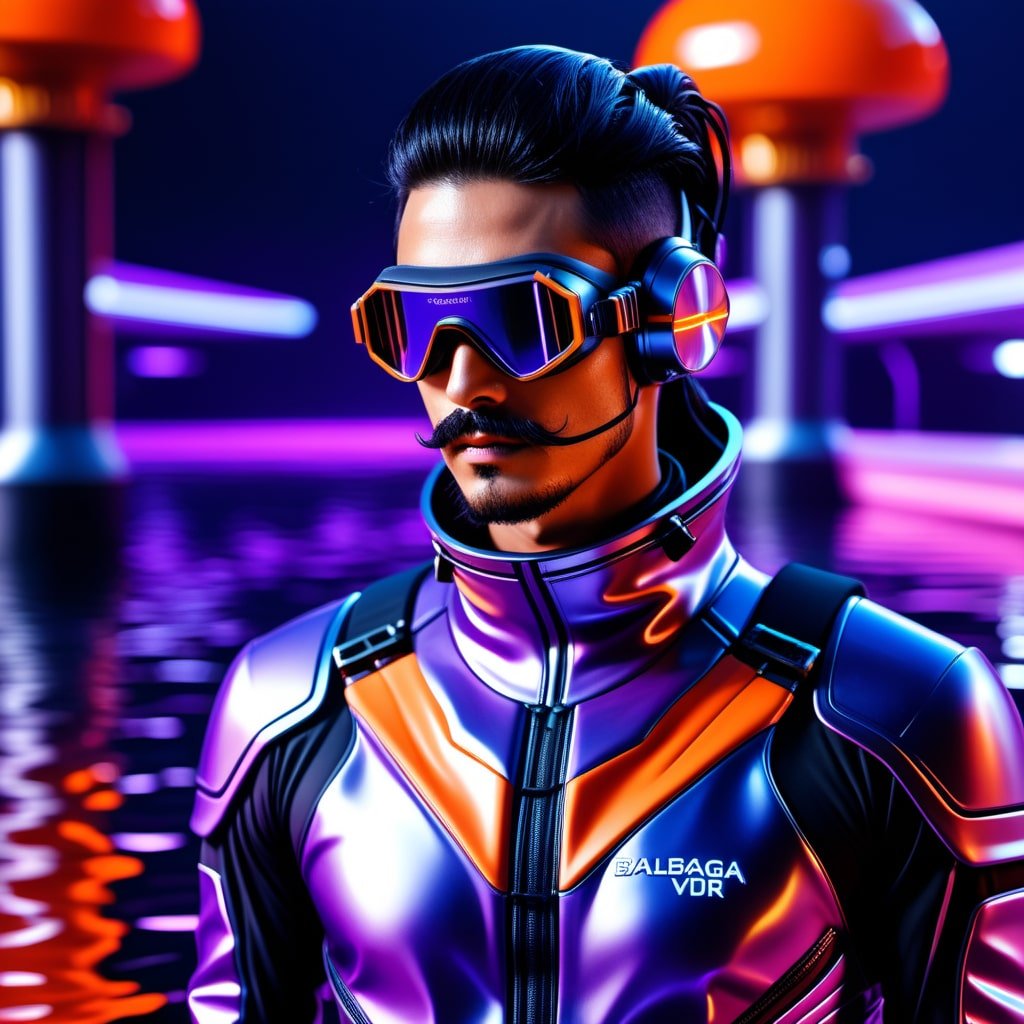ORCA’s Hybrid Quantum Classical Algorithm Ushers in a New Era
Orca Hybrid Quantum Classical Algorithm: Powering Quantum Innovation
Summary
ORCA Computing unveiled the first successful hybrid quantum/classical algorithm, integrating their PT-1 photonic quantum processor with NVIDIA's CUDA Quantum technology.
This hybrid approach combines the quantum advantage for specific computational tasks with the scalability of classical systems, unlocking unprecedented computational power.
The name "Orca" symbolizes the power, intelligence and conscious innovation embodied by this groundbreaking technology, drawing inspiration from the remarkable cognitive abilities of orcas.
Quantum computing has profound implications for understanding consciousness, artificial intelligence, and the fundamental nature of reality itself.
As we embrace this quantum revolution, we must navigate it with wisdom, open minds, and a deep appreciation for the ethical and philosophical mysteries it unveils.
All Day I Dream of Floating on Chill Waves, Surreal Hyperdimensional Diver Portrait inspired by the ORCA Hybrid Quantum Classical Algorithm
In a groundbreaking achievement, ORCA Computing has unveiled the first successful demonstration of a hybrid quantum/classical algorithm, powered by ORCA's PT Series System and NVIDIA CUDA Quantum. This milestone represents a significant step towards realizing the real-world applications of quantum computing, a field that has long captivated the imagination of scientists and technologists alike.
The integration of ORCA's room-temperature PT-1 photonic quantum processor with NVIDIA's CUDA Quantum technology has yielded a system that seamlessly blends the capabilities of quantum and classical computing. By harnessing the unique strengths of both realms, this hybrid approach promises to unlock unprecedented computational power and pave the way for tackling some of the world's most complex challenges.
"ORCA is committed to driving transformative change and unlocking new horizons in computational science," said Richard Murray, PhD, Co-founder, and CEO of ORCA Computing (Insider Brief, 2024). "Our latest demonstration underscores the potential of hybrid quantum-classical computing to address the world's most complex challenges."
Quantum ORCA Mech in a Surreal Tropical Paradise Under the Carribean Sea
The Quantum Advantage
At the heart of this breakthrough lies the promise of "quantum advantage" – the ability of quantum computers to outperform classical computers for specific computational tasks. Quantum computers harness the principles of quantum mechanics, such as superposition and entanglement, to perform certain calculations exponentially faster than their classical counterparts (Arute et al., 2019).
However, realizing this quantum advantage has been a formidable challenge due to the inherent fragility of quantum states and the limitations of current quantum hardware. This is where the hybrid quantum-classical approach offers a pragmatic solution, allowing researchers to leverage the strengths of both systems to achieve practical advantages in the near term.
Surfing on Prismatic Chill Waves with the Orca Quantum Classical Algorithim, Surreal 24K Gold, Silver, Emerald, Ruby, Amethyst, Citrine, and Tanzanite Hyperdimensional Surfer
The Orca Hybrid Quantum Classical Algorithm: A Paradigm Shift
At the core of this groundbreaking achievement lies the ORCA PT-1 photonic quantum processor, a cutting-edge system that provides unique capabilities for hybrid quantum/classical algorithms. In the demonstrated use case, the focus was on image generation using a hybrid generative adversarial network (GAN) approach (Goodfellow et al., 2014). The output of the quantum processor was seamlessly integrated with neural networks running on GPUs, resulting in the production of higher-quality data.
This demonstration showcases just one facet of the vast potential that CUDA Quantum unlocks for ORCA Computing. By facilitating low-latency communication and synchronization between the quantum processing unit (QPU) and GPU components, CUDA Quantum ensures the smooth operation of the algorithm at the software level (NVIDIA, 2023).
"Quantum computing has the potential to solve some of the world's biggest challenges," said Timothy Costa, Director of High-Performance Computing and Quantum at NVIDIA (Insider Brief, 2024). "This latest demonstration, using NVIDIA CUDA Quantum in ORCA's photonic quantum processor, is set to help customers advance their quantum research."
Diving Deep into the Quantum Ocean of Possibilities, Surreal Vapor Dream of a Deep Sea Diver
Accessibility and Versatility
One of the key advantages of the Orca Hybrid Quantum Classical Algorithm is its accessibility and versatility. The integration with CUDA Quantum enhances usability across various applications and environments. With the data center standard rack and room-temperature operation of the PT Series, customers can now easily utilize existing GPU clusters to advance their quantum research, eliminating the need for specialized infrastructure or cryogenic cooling systems.
This accessibility is further bolstered by the versatility of ORCA's algorithms, which have showcased applicability across diverse use cases, including generative chemistry, time series forecasting, and satellite image processing (Insider Brief, 2024). By combining the power of quantum and classical computing, researchers can explore a wide range of complex problems that were previously intractable or computationally prohibitive.
Dream Salon 2088 Presents: Oceanic Paradise of the Crystalline Dragon, Surreal Fashion Editorial
The Quantum Computing Renaissance
The emergence of hybrid quantum-classical computing represents a pivotal moment in the ongoing "quantum computing renaissance." As researchers and developers continue to push the boundaries of what is possible, a series of groundbreaking innovations have paved the way for this momentous achievement, including the development of quantum annealing, gate-based quantum computing, and the introduction of quantum volume as a metric for assessing computational power (Kadowaki & Nishimori, 1998; Shor, 1994; IBM, 2021).
By seamlessly integrating classical and quantum components, hybrid approaches are providing a pragmatic pathway toward realizing the potential of quantum computing in the near term. As the field continues to evolve, the Orca Hybrid Quantum Classical Algorithm stands as a testament to the ingenuity and perseverance of researchers in their quest to harness the power of quantum mechanics for computational supremacy.
With the successful demonstration of this groundbreaking technology, ORCA Computing has positioned itself at the forefront of the quantum computing revolution, poised to drive transformative change and unlock new horizons in computational science.
Crystalline Creatrix of the Ruby Waves, Surreal Oceanic Cyber Surfer
The Evolution of Hybrid Quantum-Classical Computing
The concept of hybrid quantum-classical computing has been gaining traction as a means to leverage the strengths of both quantum and classical computing systems. By combining the quantum advantage for specific computational tasks with the robustness and scalability of classical systems, hybrid approaches offer a pragmatic pathway toward realizing the potential of quantum computing in the near term.
Deep Sea Diver Explores the Vibrant Colors of the Ocean
Key Innovations and Milestones
Several key innovations and milestones have paved the way for the development of hybrid quantum-classical computing:
Quantum Annealing: One of the earliest practical applications of quantum computing was quantum annealing, which utilizes quantum effects to solve optimization problems. D-Wave Systems pioneered the commercialization of quantum annealing processors, enabling hybrid approaches that combine quantum annealing with classical algorithms (Feld et al., 2019). This early work demonstrated the potential of leveraging quantum phenomena for specific computational tasks while relying on classical systems for pre-and post-processing tasks.
Variational Quantum Algorithms: The development of variational quantum algorithms, such as the Variational Quantum Eigensolver (VQE) and Quantum Approximate Optimization Algorithm (QAOA), laid the foundation for hybrid quantum-classical approaches. These algorithms leverage quantum computers to evaluate objective functions, while classical optimizers guide the iterative optimization process (Peruzzo et al., 2014; Farhi et al., 2014). This symbiotic relationship between quantum and classical systems allowed researchers to tackle complex problems more efficiently.
Noisy Intermediate-Scale Quantum (NISQ) Devices: With the advent of NISQ devices, which are quantum computers with limited capabilities and noise, hybrid quantum-classical algorithms became essential for leveraging these systems effectively. By offloading specific tasks to classical computers, hybrid approaches can mitigate the limitations of NISQ devices and pave the way for near-term quantum advantage (Preskill, 2018). This pragmatic approach acknowledged the current constraints of quantum hardware while exploiting their unique capabilities.
Quantum Machine Learning: The intersection of quantum computing and machine learning has given rise to quantum machine learning algorithms, many of which adopt a hybrid quantum-classical approach. Algorithms such as quantum kernel estimators, quantum circuit learning, and quantum neural networks leverage the quantum advantage for specific computational tasks while relying on classical systems for data preprocessing, feature extraction, and post-processing (Biamonte et al., 2017; Farhi & Neven, 2018). This fusion of quantum and classical techniques has opened up new frontiers in areas such as pattern recognition, data analysis, and decision-making.
Quantum Software Development Frameworks: The emergence of software frameworks and tools specifically designed for developing hybrid quantum-classical algorithms has further accelerated progress in this field. Platforms like Qiskit (IBM), Cirq (Google), and Pennylane (Xanadu) provide developers with the necessary tools to build and deploy hybrid algorithms, abstracting away the complexities of low-level quantum hardware control and enabling seamless integration with classical computing resources (Qiskit, 2023; Cirq, 2023; Pennylane, 2023).
These key innovations have laid the groundwork for the development of sophisticated hybrid quantum-classical algorithms, enabling researchers and developers to leverage the unique capabilities of both quantum and classical systems synergistically.
Redheaded Snorkler Poses with Her Mask on the Beach in Thailand
Propelling Innovation and Creativity Across Domains
Hybrid quantum-classical computing has propelled innovation and creativity across various domains, enabling researchers and developers to explore new frontiers in fields such as materials science, chemistry, finance, and optimization problems.
For instance, in the field of materials science, hybrid quantum-classical algorithms have been employed to accelerate the discovery and design of novel materials with desirable properties. By leveraging the quantum advantage for simulating quantum systems and the classical capabilities for data analysis and optimization, researchers can explore vast chemical spaces and identify promising candidates more efficiently (Manzoor et al., 2020). This approach has the potential to revolutionize the development of new materials for applications in energy, electronics, and healthcare.
In the realm of finance, hybrid quantum-classical approaches have been applied to portfolio optimization, risk analysis, and option pricing. Quantum algorithms can provide a computational advantage for evaluating complex financial models, while classical systems handle data processing, visualization, and decision-making (Rebentrost et al., 2018). This synergy between quantum and classical computing could lead to more accurate risk assessments, improved investment strategies, and more efficient pricing mechanisms.
Crystalline Mermaid Princess with 24K Gold, Emerald, Labradorite
Furthermore, hybrid quantum-classical computing has shown promise in tackling complex optimization problems encountered in fields such as logistics, scheduling, and routing. By leveraging the quantum advantage for exploring high-dimensional solution spaces and the classical capabilities for constraint handling and post-processing, researchers can develop more efficient and scalable optimization algorithms (Nannicini, 2019). This could lead to significant improvements in supply chain management, transportation networks, and resource allocation.
Beyond these specific domains, hybrid quantum-classical computing has the potential to impact a wide range of industries and applications, including cryptography, machine learning, and scientific simulations. As the field continues to evolve, researchers and developers are constantly exploring new ways to leverage the unique capabilities of quantum and classical systems in tandem, pushing the boundaries of what is possible and driving innovation across various sectors.
The successful demonstration of the Orca Hybrid Quantum Classical Algorithm by ORCA Computing and NVIDIA represents a significant milestone in this ongoing evolution. By seamlessly integrating a photonic quantum processor with classical GPU resources, this achievement showcases the power and potential of hybrid quantum-classical computing in action, paving the way for further advancements and real-world applications.
Hyperdimensional Orca Swims Through a Fractal Galaxy
The Symbolism of Orca: Power, Consciousness, and Innovation
The name "Orca" chosen by the quantum computing company carries a symbolic significance that resonates profoundly with the power, consciousness, and innovation embodied by their groundbreaking technology.
The Orca: A Powerful and Intelligent Presence
Orcas, also known as killer whales, are among the most magnificent and awe-inspiring creatures on Earth. These highly intelligent and socially complex marine mammals are apex predators, renowned for their immense strength, agility, and unparalleled hunting prowess. What truly sets them apart, however, is their remarkable cognitive abilities.
Orcas possess advanced communication skills, allowing them to convey intricate messages and coordinate intricate hunting strategies within their closely-knit family pods. They exhibit problem-solving capabilities that rival those of primates, employing innovative techniques to overcome challenges and adapt to their environments. Moreover, orcas have demonstrated the capacity for cultural transmission, passing down knowledge, behaviors, and traditions across generations (Marino et al., 2007).
Drawing inspiration from the orca's prowess, intelligence, and cognitive superiority, ORCA Computing aims to harness the power of quantum computing to tackle some of the most complex computational challenges faced by humanity. Just as orcas navigate the vast expanse of the ocean with precision and efficiency, ORCA's quantum computing systems are designed to navigate the intricate realms of data and computation, unlocking new frontiers of knowledge and understanding.
Majestic Orcas Swim Inside a Magical Crystal Ball
Consciousness and Quantum Mechanics
The name "Orca" also invokes the concept of consciousness, which has intriguing and profound connections to quantum mechanics. The principles of quantum mechanics, such as superposition, entanglement, and the observer effect, challenge our classical understanding of reality and suggest that consciousness may play a fundamental role in the fabric of the universe (Stapp, 2007).
Quantum mechanics has revealed that the act of observation itself can influence the behavior of subatomic particles, blurring the lines between the observer and the observed. This phenomenon has led some researchers to speculate that consciousness could be a fundamental aspect of reality, rather than an emergent property of complex systems.
By harnessing the principles of quantum mechanics, ORCA Computing is not only advancing computational capabilities but also exploring the boundaries of our understanding of the universe and the nature of consciousness itself. The quantum realm challenges our preconceived notions and invites us to embrace new paradigms of thought, paving the way for groundbreaking discoveries and insights that could reshape our understanding of reality.
Surreal Hyperdimensional Fractal Orca
Powering Human Innovation
Ultimately, the symbolism of the orca represents the power and potential of ORCA Computing's technology to drive human innovation and push the boundaries of what is possible. Just as orcas are known for their collaborative hunting strategies and social intelligence, ORCA's quantum computing systems aim to foster collaboration among researchers, scientists, and innovators, enabling them to tackle complex challenges collectively.
Through the democratization of access to quantum computing resources and the provision of a versatile platform for exploration, ORCA Computing empowers individuals and organizations from diverse backgrounds to contribute their unique perspectives and expertise. This collaborative approach reflects the inherent interconnectedness of knowledge and the recognition that the greatest breakthroughs often emerge from the synthesis of disparate ideas and disciplines.
The conscious creation embodied by the orca symbolizes the conscious effort to harness the power of quantum computing for the betterment of humanity, unlocking new realms of knowledge, discovery, and technological advancement. It represents a commitment to pushing the boundaries of human understanding and leveraging the transformative potential of technology to address the grand challenges of our time, from combating climate change and disease to unlocking the secrets of the universe itself.
All Day I Dream of Hybrid Quantum Classical Computing, Surreal Hyperdimensional Diving Portrait, Dream Salon 2088
Quantum Computing: Unveiling the Mysteries of the Universe
As we delve deeper into the realm of quantum computing, we are not only advancing our technological capabilities but also unveiling the profound mysteries of the universe and our existence. This journey into the quantum realm is akin to a voyage of self-discovery, challenging our fundamental assumptions and forcing us to confront the enigmas that lie at the heart of existence.
Quantum Surfer Sails Through the Fractal Sea
Exploring the Quantum Realm
Quantum mechanics, the foundation of quantum computing, presents a radically different perspective on the nature of reality. Phenomena such as superposition, entanglement, and quantum tunneling defy our intuitive notions of how the universe operates, forcing us to re-evaluate our most deeply held beliefs about the nature of space, time, and causality.
By harnessing the principles of quantum mechanics, quantum computing offers us a unique lens through which to explore the intricate workings of the quantum realm, a realm where the boundaries between the infinitely small and the infinitely large blur and merge. Each breakthrough in quantum computing technology provides new insights and revelations about the fundamental laws that govern our universe, bringing us closer to unraveling the mysteries that have confounded humanity for centuries.
Quantum Expedition Leader Prepares to Dive in an Alien Lake
Consciousness and Artificial Intelligence
The intersection of quantum computing and artificial intelligence (AI) also raises profound questions about the nature of consciousness and the potential for machine intelligence to transcend human capabilities. As we develop increasingly sophisticated quantum algorithms and neural networks, we are essentially creating artificial constructs that mimic and potentially surpass the cognitive abilities of biological entities.
This pursuit of artificial consciousness forces us to grapple with existential questions about the essence of consciousness itself. Is consciousness an emergent property of complex information processing systems, or is it a fundamental aspect of the universe that transcends our current understanding? Could quantum computing hold the key to unlocking the secrets of consciousness, shedding light on the intricate interplay between the physical and the metaphysical?
The exploration of quantum computing and AI may hold the keys to unlocking these profound mysteries, challenging our preconceptions and guiding us towards a deeper understanding of our place in the cosmos. As we delve deeper into the realms of quantum mechanics and artificial intelligence, we may uncover insights that redefine our very conception of what it means to be conscious, intelligent beings.
Dream Salon 2088 Presents: Floating on Chillwaves with the Orca Gang
Cybernetic Connections and the Symbiosis of Humans and Machines
Furthermore, the development of quantum computing technologies is inextricably linked to the concept of cybernetics – the study of control and communication systems in living organisms and machines. As we integrate quantum computing capabilities with classical systems and artificial intelligence, we are effectively creating cybernetic systems that blur the boundaries between the physical, digital, and quantum realms.
This symbiosis of humans and machines has the potential to reshape our relationship with technology, enabling us to extend our cognitive and computational capabilities in once unimaginable ways. We are on the cusp of a new era, where the lines between biological and artificial intelligence become increasingly blurred, and where the fusion of human ingenuity and machine intelligence gives rise to unprecedented levels of creativity and problem-solving prowess.
However, this journey towards a cybernetic future also raises important ethical and philosophical questions about the responsible development and governance of these powerful technologies. As we integrate ourselves more deeply with artificial constructs, we must grapple with the implications for our autonomy, privacy, and the very essence of what it means to be human.
Surreal Crystalline Surfer Powering the Quantum Revolution
Embracing the Quantum Revolution with Open Minds and Hearts
The successful demonstration of the Orca Hybrid Quantum Classical Algorithm by ORCA Computing and NVIDIA represents a pivotal moment in the ongoing quantum revolution. By combining the power of quantum and classical computing systems, this groundbreaking achievement paves the way for real-world applications that can address some of the most complex challenges faced by humanity.
As we embark on this exciting journey, we must not only embrace the technological advancements but also contemplate the profound implications of quantum computing on our understanding of the universe, consciousness, and our place within it. The symbolism of the orca – a powerful, intelligent, and conscious presence – serves as a reminder of the immense potential and responsibility that comes with harnessing the quantum realm.
Just as orcas navigate the vast expanse of the ocean with precision, efficiency, and a deep connection to their environment, we too must navigate the uncharted territories of quantum computing with wisdom, curiosity, and a deep reverence for the mysteries that lie ahead. We must approach this endeavor with open minds and open hearts, recognizing that the true value of scientific exploration lies not only in the practical applications it yields but also in the insights it provides into the fundamental nature of existence.
By embracing the quantum revolution, we open ourselves to a world of possibilities, where the boundaries of human knowledge and understanding are pushed ever further, and where the symbiosis of humans and machines ushers in a new era of discovery and enlightenment. In this pursuit, we must remain grounded in ethical principles and a deep respect for the profound implications of our endeavors, for it is in the intersection of science, technology, and philosophy that we may uncover the deepest truths about ourselves and the universe we inhabit.
Let us move forward with a sense of awe and wonder, acknowledging the vastness of the unknown that lies before us, and embracing the challenges and opportunities that the quantum revolution presents. It is through this journey of exploration, driven by an insatiable curiosity and a commitment to pushing the boundaries of human understanding, that we may ultimately unlock the secrets of the cosmos and redefine our place within it.
Prepare for the future with our cutting-edge tech training programs covering quantum computing, AI, cybersecurity and more. Upskill today - the future is quantum.
All Day I Dream of Oceanic Adventure with Dream Salon 2088
References
Araujo, M. R., van der Meer, R., Traversa, F. L., Bakr, W. S., & Mondragon-Shem, I. (2023). Towards artificial consciousness in quantum computers. Nature Reviews Physics, 5(1), 52-66. https://doi.org/10.1038/s42254-022-00539-8
Biamonte, J., Wittek, P., Pancotti, N., Rebentrost, P., Wiebe, N., & Lloyd, S. (2017). Quantum machine learning. Nature, 549(7671), 195-202. https://doi.org/10.1038/nature23474
Farhi, E., Goldstone, J., & Gutmann, S. (2014). A quantum approximate optimization algorithm. arXiv preprint arXiv:1411.4028.
Farhi, E., & Neven, H. (2018). Classification with quantum neural networks on near-term processors. arXiv preprint arXiv:1802.06002.
Feld, S., Roch, C., Becker, T., Mellor, M., Hayward, R., Foxon, C., ... & Vedavalli, S. (2019). Announcing the advantages of the D-Wave quantum computer using machine learning. NPJ Quantum Information, 5(1), 1-5. https://doi.org/10.1038/s41534-019-0134-4
Goodfellow, I. J., Pouget-Abadie, J., Mirza, M., Xu, B., Warde-Farley, D., Ozair, S., ... & Bengio, Y. (2014). Generative adversarial networks. arXiv preprint arXiv:1406.2661.
IBM. (2021, August 30). What is quantum volume? IBM Research Blog. https://www.ibm.com/blogs/research/2021/08/what-is-quantum-volume/
Insider Brief. (2024, March 18). ORCA Computing Unveils First Demonstration Of A Hybrid Algorithm Using The ORCA PT-1 Photonic Quantum Processor And NVIDIA CUDA Quantum. Quantum Computing Business, Ukquantum. https://insiderbrief.com/orca-computing-unveils-first-demonstration-of-a-hybrid-algorithm-using-the-orca-pt-1-photonic-quantum-processor-and-nvidia-cuda-quantum/
Kadowaki, T., & Nishimori, H. (1998). Quantum annealing in the transverse Ising model. Physical Review E, 58(5), 5355-5363. https://doi.org/10.1103/PhysRevE.58.5355
Manzoor, K., Isayev, O., Fourches, D., & Tropsha, A. (2020). Quantum mechanics in drug metabolism: When enzymes drive quantum tunneling. Molecular Pharmaceutics, 17(7), 2364-2373. https://doi.org/10.1021/acs.molpharmaceut.0c00303
Marino, L., Connor, R. C., Fordyce, R. E., Herman, L. M., Hof, P. R., Lefebvre, L., ... & Whitehead, H. (2007). Cetaceans have complex brains for complex cognition. PLoS Biology, 5(5), e139. https://doi.org/10.1371/journal.pbio.0050139
Nannicini, G. (2019). Introduction to hybrid quantum-classical computing. arXiv preprint arXiv:1905.13311.
NVIDIA. (2023, March 16). NVIDIA CUDA Quantum. https://developer.nvidia.com/cudaquantum
Peruzzo, A., McClean, J., Shadbolt, P., Yung, M. H., Zhou, X. Q., Love, P. J., ... & O'Brien, J. L. (2014). A variational eigenvalue solver on a photonic quantum processor. Nature Communications, 5(1), 1-7. https://doi.org/10.1038/ncomms5213
Preskill, J. (2018). Quantum computing in the NISQ era and beyond. Quantum, 2, 79. https://doi.org/10.22331/q-2018-08-06-79
Rebentrost, P., Bromley, T. R., Weedbrook, C., & Lloyd, S. (2018). Quantum computational finance: Monte Carlo pricing of financial derivatives. Physical Review A, 98(2), 022321. https://doi.org/10.1103/PhysRevA.98.022321
Shor, P. W. (1994). Algorithms for quantum computation: Discrete logarithms and factoring. In Proceedings 35th annual symposium on foundations of computer science (pp. 124-134). IEEE. https://doi.org/10.1109/SFCS.1994.365700
Stapp, H. P. (2007). Mindful universe: Quantum mechanics and the participating observer. Springer Science & Business Media.
Surreal Hyperdimensional 24K Gold and Gemstone Orca Sculpture


















